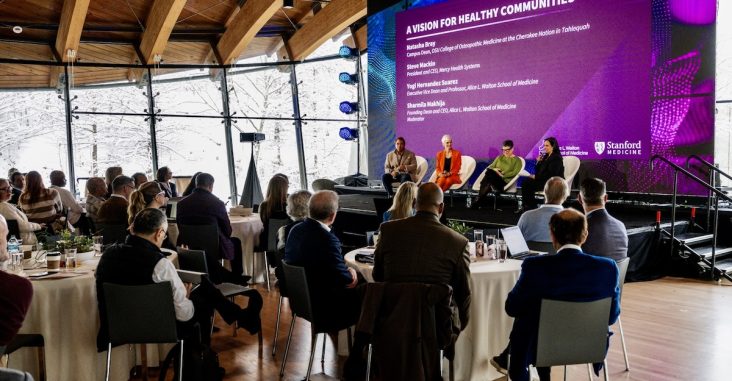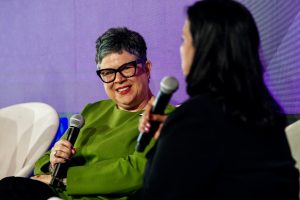Health care leaders highlight AI use in health care at Bentonville conference
by January 10, 2025 6:19 pm 1,819 views

A panel discussion on rural health care was part of a health care conference regarding artificial intelligence. More than 200 people attended the invitation-only conference at Crystal Bridges Museum of American Art on Friday (Jan. 10). (photo courtesy of Meredith Mashburn)
More than 200 people braved the elements and attended a conference in Bentonville to learn how artificial intelligence (AI) might benefit the health care industry. The first session focused on health care access in rural areas.
The Alice L. Walton School of Medicine (AWSOM) and Stanford Medicine hosted Think Health: AI for Healthy Communities at Crystal Bridges Museum of American Art on Friday (Jan. 10). The invitation-only conference included national leaders in health care, technology, education and policymaking.
Philanthropist Alice Walton, founder of AWSOM and Heartland Whole Health Institute, said the event will be hosted annually. The 85,000-square-foot Heartland Whole Health Institute is expected to be completed by April, and the 154,000-square-foot AWSOM will start classes in July. They are being built on a 134-acre art and wellness campus that includes Crystal Bridges, which is undergoing a 100,000-square-foot expansion to be completed in 2026.
Area media were invited to attend the first session regarding using AI to benefit rural health care. Link here for the full conference agenda.
The session, A Vision for Healthy Communities, started with Jonathan Chen, assistant professor of medicine and biomedical data science at Stanford Medicine, who was introduced by an AI-generated avatar of himself. Chen said AI has helped him become a better doctor by improving his communication skills with patients and their families. With AI, he can “practice a difficult, high-stakes conversation in a low-stakes environment.” He also quoted a colleague who said those who learn to use AI might replace those who do not.

Chen was followed by a panel discussion that included Natasha Bray, dean of Oklahoma State University College of Osteopathic Medicine at the Cherokee Nation in Tahlequah; Steve Mackin, president and CEO of St. Louis-based health care system Mercy; and Yogi Hernandez Suarez, executive vice dean and professor of AWSOM. Sharmila Makhija, founding dean and CEO of AWSOM, was the moderator.
Panelists discussed rural health challenges and ways they address them, including using technology. One of the challenges Bray discussed was the life expectancy of residents of Stilwell, Okla., about an hour southwest of Bentonville. She said that the life expectancy is 56.4 years.
“That raises questions,” she said. “Why is that, and what are the contributing factors to that?”
She said OSU looks to address the health needs of rural communities. Its work includes training physicians who will be a part of those communities. She added that many community health challenges are not health care-related but include education level, access to food and pharmacies, and a lack of high-speed internet and cell phone service.
SERVICE GAP
Mackin said Mercy opened its first virtual hospital in 2014 to close a gap in health care between rural areas and its hospitals. This led the company to more collaborative and team-based care models and to become accustomed to technology.
He said staff at its hospital in Berryville, which is more than an hour east of Bentonville, collaborates with its St. Louis staff to determine whether a stroke patient needs to be transferred to another hospital, such as the one in Rogers, or can be treated on-site. He added that the earnings of the hospitals, like the one in Berryville, allow Mercy to continue to invest in rural areas.
“We’re going to grow a generation of physicians who have a very different notion of what collaborative care looks like, what team-based care looks like, what technology-enablement means,” Mackin said. “They’re going to embrace it. And as technologies continue to evolve, they’re going to be excited and eager to integrate that into their model of care and their practice every day.”
Makhija said Mercy is the educational partner for AWSOM. Its first class of 48 medical students will start on July 19. She said that within the two months of starting medical school, students will receive early clinical experience led by a Mercy physician.
Mackin said Mercy has implemented more than 125 AI and machine learning models that operate “behind the scenes — many of them that impact patient care… Our physicians embrace it, and we’re able to scale those solutions.” Mercy recently implemented technology to improve the transfer of patients from the emergency department to in-patient care. He said this will take place over 225,000 times this year. He said consistency across the health system allows it to implement AI.
DENOMINATOR DOCTORS
Suarez said she was taught to be a numerator doctor or to treat patients one by one. She said that’s no longer sufficient and that denominator doctors are needed. They see groups of patients, populations, communities, and societies. It’s a system of care “that puts patient outcomes in the middle and then starts to wrap everything we’re talking about to get to those health outcomes that my colleague just mentioned. Yes, processes but outcomes is the holy grail.”
Suarez joked that in the ‘80s students only needed to be smart to get into medical school.
“Now, we’re looking for so many other characteristics, values and capabilities. … We are really being mindful about the kind of folks we’re bringing in.”
Suarez said AWSOM does that by “not shying away from what we want to do boldly. The students that are going to come to us are going to be risk-takers with us, and that first class is always remarkable, right? They’re going to help shape our journey. There’s no lack of feedback I imagine we’re going to get from 48 young people who are going to tell us how we can improve what we’re doing.”
She said almost two-thirds of patients don’t take the medications that physicians prescribe.
“We really need that partnership, which starts with trust but has to be built on health literacy and understanding,” said Suarez, adding that AI can bring insights to physicians about their patients.
Bray said AI can help physicians share information with patients in a way that “meets that patient where they are that understands what their health priorities are. So when we’re talking about the medicines that they’re not taking because they can’t pay their bills or buy shoes for their kids to go back to school, how do we begin to balance those things?”
She said students can be taught to use tools “to support and augment and engage with patients so that they’re able to share that information with us in a trustworthy way and we’re able to adapt our recommendations and opinion that they actually make sense. If a patient can’t afford their meds, if they can’t afford their groceries, they’re never going to be able to follow the recommendations that we’re giving them.”
This impacts their health, their family and the community, she said.
HARRIS Q&A
After the first session, Walter Harris, president of health strategy and delivery of Art and Wellness Enterprises, said the health care industry is experiencing multiple challenges, including a lack of health care workers. The AI conference is expected to open up ideas to leverage technology. He views AI as more about augmentation than artificial.
The aim is to raise patients’ quality of experience, reduce health care costs, increase access and “most importantly, how do we remove the taxation on doctors and nurses and those providers to make life easier and better for them as well as the patient,” Harris said. “So, this AI conference is having us step back and think about health care in very different ways.”
Asked about AI’s significance to health care and whether it can be trusted with our health, Harris said, “Yes, but…how far do we allow technology to drive decisions on patients? You do need a bit of technology to help.”
Harris noted the benefits of AI technology that allow physicians to spend quality time with their patients and be relieved of administrative burdens. Barriers to greater AI use include a lack of trust and understanding of the technology and willingness to give full control to it.
“This is what we’re talking about today of balancing all those things,” he said. “We’re not just saying AI is going to actually become a doctor. We’re saying AI is going to support a doctor.”
Asked how AI fits into the $700 million agreement with the Alice L. Walton Foundation, the health institute and Mercy, Harris said Mercy’s innovative spirit surrounding virtual technology was a top reason why Mercy was selected as a partner. Its virtual model in St. Louis is something they want to replicate.
